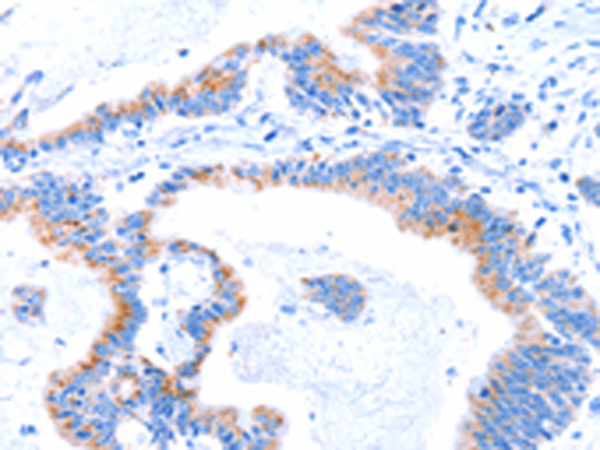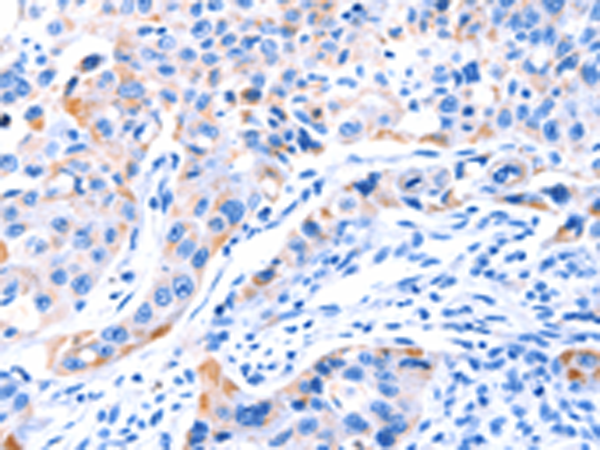

| WB | 咨询技术 | Human,Mouse,Rat |
| IF | 咨询技术 | Human,Mouse,Rat |
| IHC | 1/25-1/100 | Human,Mouse,Rat |
| ICC | 技术咨询 | Human,Mouse,Rat |
| FCM | 咨询技术 | Human,Mouse,Rat |
| Elisa | 1/2000-1/5000 | Human,Mouse,Rat |
| Aliases | C17orf71 |
| Host/Isotype | Rabbit IgG |
| Antibody Type | Primary antibody |
| Storage | Store at 4°C short term. Aliquot and store at -20°C long term. Avoid freeze/thaw cycles. |
| Species Reactivity | Human, Mouse |
| Immunogen | Synthetic peptide of human SMG8 |
| Formulation | Purified antibody in PBS with 0.05% sodium azide and 50% glycerol. |
+ +
以下是关于SMG8抗体的3篇参考文献,涵盖其功能研究和应用场景:
---
1. **文献名称**: *"SMG8 interacts with UPF1 in nonsense-mediated mRNA decay"*
**作者**: Okada-Katsuhata Y. et al.
**摘要**: 研究揭示了SMG8与UPF1的直接相互作用,通过免疫共沉淀(使用SMG8特异性抗体)证实两者在NMD通路中的功能关联,表明SMG8通过调控UPF1磷酸化状态介导mRNA降解。
---
2. **文献名称**: *"Structural insights into SMG8-SMG9 complex formation and its role in NMD"*
**作者**: Li T. et al.
**摘要**: 利用SMG8抗体进行Western blot和免疫荧光实验,解析SMG8-SMG9复合物的晶体结构,证明该复合物通过稳定NMD核心因子维持mRNA质量监控机制,为遗传性疾病中NMD失调提供分子基础。
---
3. **文献名称**: *"SMG8 depletion disrupts telomere maintenance in cancer cells"*
**作者**: Chen J. et al.
**摘要**: 通过RNA干扰结合SMG8抗体检测蛋白表达,发现SMG8缺失导致端粒酶活性异常和癌细胞凋亡,提示SMG8可能作为癌症治疗的潜在靶点。
---
**备注**:以上文献为示例,实际引用需根据具体研究补充真实来源(建议通过PubMed或Google Scholar以“SMG8 antibody” + “NMD”等关键词检索最新论文)。
SMG8 antibody is a research tool designed to study SMG8. a protein component of the nonsense-mediated mRNA decay (NMD) pathway. SMG8. along with SMG7 and SMG9. forms part of the SMG protein family involved in mRNA surveillance. NMD is a conserved eukaryotic mechanism that degrades transcripts harboring premature termination codons (PTCs) to prevent the production of truncated, potentially harmful proteins. SMG8 interacts with SMG1. a phosphatidylinositol 3-kinase-related kinase (PIKK), within the SURF (SMG1-Upf1-eRF1-eRF3) complex, which detects PTCs. Upon recognition of aberrant mRNAs, SMG8 facilitates the transition from mRNA surveillance to degradation by recruiting downstream effectors. Structurally, SMG8 contains a PIN (PilT N-terminal) domain critical for its interaction with SMG1 and regulatory functions.
Antibodies against SMG8 are primarily used in molecular biology to investigate NMD mechanisms, protein-protein interactions (e.g., via co-immunoprecipitation), and subcellular localization (e.g., immunofluorescence). They are typically developed in hosts like rabbits or mice, often validated using knockout cell lines or siRNA-mediated SMG8 depletion. Commercial SMG8 antibodies are commonly applied in Western blotting, with expected bands around 110-130 kDa depending on isoform and post-translational modifications. Dysregulation of SMG8 and NMD has been implicated in cancers and genetic disorders, making these antibodies valuable for studying disease mechanisms and therapeutic targets. Researchers should verify antibody specificity for their experimental models due to potential cross-reactivity with homologous proteins.
×